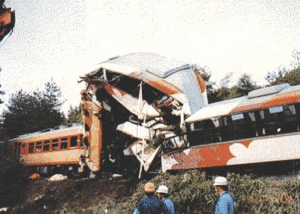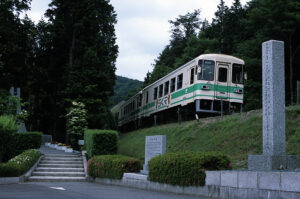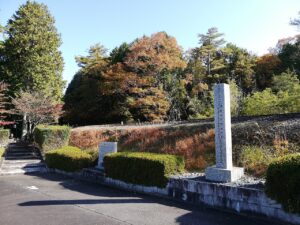commuter

 Serious accidents happen, and they are almost always due to negligence on the side of one party or the other, but when two automobiles, planes, ships, or trains hit each other head-on, someone was seriously in the wrong place and going the wrong way. On May 14, 1991, two diesel trains carrying commuters crashed head-on, near Shigaraki, Japan, killing 42 people and injuring over 600 others. This was the worst rail disaster in Japan since a November 1963 Yokohama crash, which killed 160 people.
Serious accidents happen, and they are almost always due to negligence on the side of one party or the other, but when two automobiles, planes, ships, or trains hit each other head-on, someone was seriously in the wrong place and going the wrong way. On May 14, 1991, two diesel trains carrying commuters crashed head-on, near Shigaraki, Japan, killing 42 people and injuring over 600 others. This was the worst rail disaster in Japan since a November 1963 Yokohama crash, which killed 160 people.
Shigaraki, a town near Kyoto, is famous for its ceramics. On that May 14th, the World Ceramics Festival was being held in the town. That put many more people in town than normal. It also filled the passenger trains with people on their way to the event. At just after 10am, passengers filled a train in Kikukawa, which was to run along a 9.1-mile single-track rail line away from Shigaraki. When the train was loaded, the However, workers on the Shigaraki Kogen Railways (SKR) line prepared to depart, but they could not get a green signal indicating that the track was clear so they could  depart from the station. The system showed that a train was approaching. The workers believed the signal was malfunctioning, and so they overrode the system and sent the train out, 11 minutes late.
depart from the station. The system showed that a train was approaching. The workers believed the signal was malfunctioning, and so they overrode the system and sent the train out, 11 minutes late.
Sadly, they were to find out too late that the system had been correct and a JR West commuter train carrying passengers toward Shigaraki for the festival was speeding toward them. The only mechanical failure that day was when a faulty-departure detector failed to work correctly, sending the JR West commuter train out on a collision course with the SKR train. The resulting crash derailed both trains and cost 42 people their lives. Very seldom does the fault in an accident lie with just one person. A subsequent investigation faulted the SKR workers for allowing the train to depart without a green signal, an action found to be dangerous and illegal. A signal engineer was also blamed for the defective wiring that led to the failure of the faulty-departure detector that should have prevented the collision. A 1999 civil trial resulted in a 500-million-yen (3,196,500 US dollars) award to the victims against SKR and JR West jointly. JR West pledged 
 safety improvements (after the Shigaraki accident), but it again had an accident in Amagasaki. The Amagasaki rail crash was a fatal railway accident that occurred on April 25, 2005, at 9:19am local time. Of the roughly 700 passengers (initial estimate was 580 passengers) on board at the time of the crash, 106 passengers, in addition to the driver, were killed and 562 others injured. Each year, since the disaster, the victims of the Shigaraki Head-On collision are remembered in a ceremony in Shigaraki.
safety improvements (after the Shigaraki accident), but it again had an accident in Amagasaki. The Amagasaki rail crash was a fatal railway accident that occurred on April 25, 2005, at 9:19am local time. Of the roughly 700 passengers (initial estimate was 580 passengers) on board at the time of the crash, 106 passengers, in addition to the driver, were killed and 562 others injured. Each year, since the disaster, the victims of the Shigaraki Head-On collision are remembered in a ceremony in Shigaraki.

